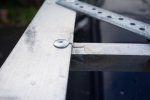How many clips do you have on it? I'd think that 2 on the rear, and perhaps 1 along each side would be plenty?
Also, I wouldn't worry too much about the clips coming off in transit. I'm using 2 of those on my m101 and while I occasionally lock it (if in a city), they've never come off, despite some really bumpy trails.
Edit, nm, I just saw the part where you'll use these for mounting points for the hard sides. Although still ways to do that without having to have clips all along the side.
Also, I wouldn't worry too much about the clips coming off in transit. I'm using 2 of those on my m101 and while I occasionally lock it (if in a city), they've never come off, despite some really bumpy trails.
Edit, nm, I just saw the part where you'll use these for mounting points for the hard sides. Although still ways to do that without having to have clips all along the side.











